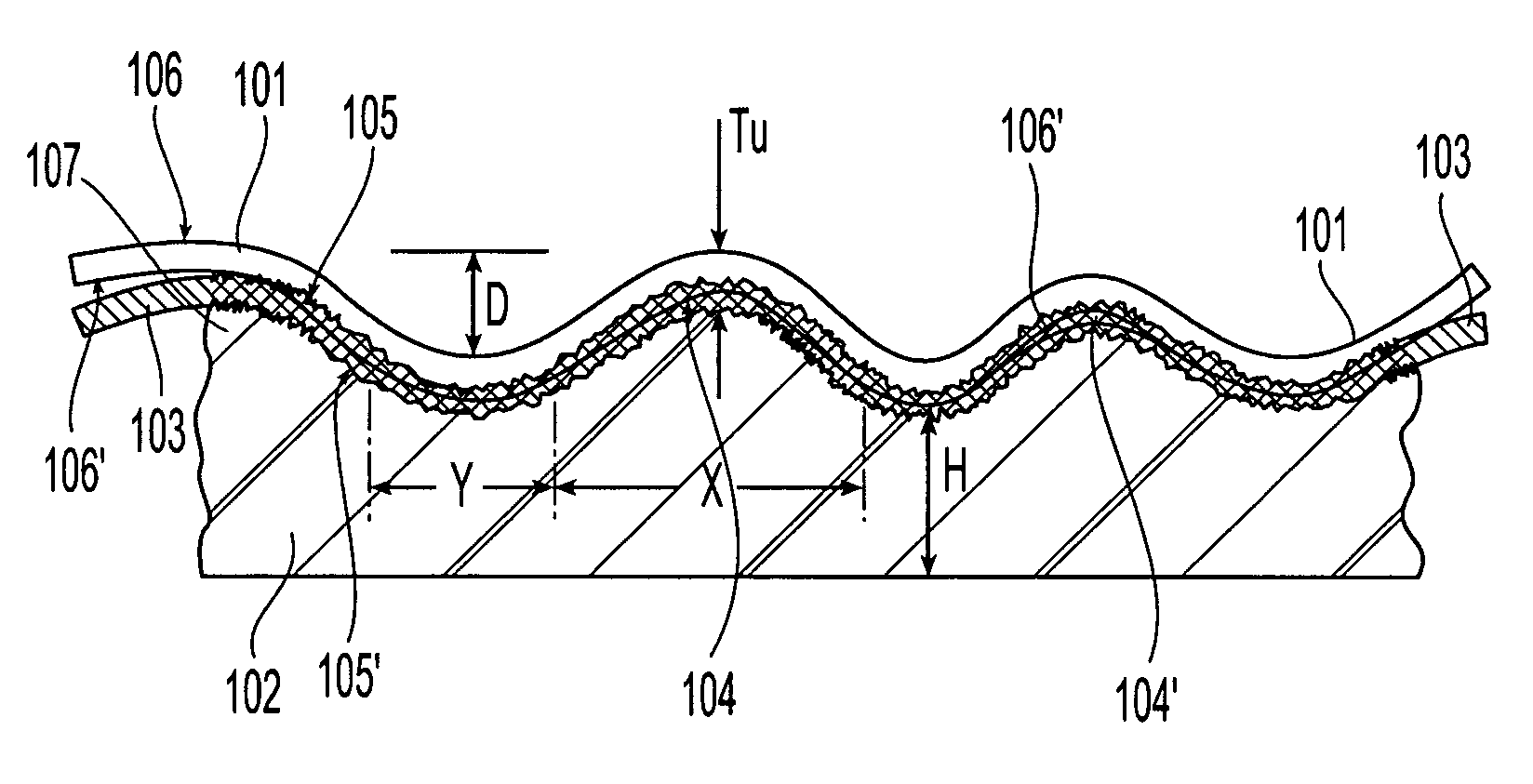Spring-like textured composite floorcovering
a composite material and spring-like technology, applied in knitting machines, weaving, knitting, etc., can solve the problems of difficult cleaning and sanitizing, less durable, and softness of solid surface cover materials,
- Summary
- Abstract
- Description
- Claims
- Application Information
AI Technical Summary
Benefits of technology
Problems solved by technology
Method used
Image
Examples
example 1
[0112]Textured composite material according to an embodiment the present invention was prepared.
[0113]A series of textured composite materials was prepared using the following component materials. The fibrous outer layer was a needle-punched felt fabric made by carding and cross-lapping a 0.19 kg / m2 (5.5 oz / yd2) weight, 2.2 mm thickness felt of 3.8 cm (1.5 inch.) 1.7×10−7 kg / m (1.5 denier) polyester fibers. Needling density was 46.5 penetrations / cm2 (300 pen / inch2). The adhesive layer material was a combination of two layers of black polyethylene utility film having a basis weight of 0.15 kg / m2 (4.4 oz / yd2). The backing layer was commercial carpet padding material of 0.88 kg / m2 (26 oz / yd2) of carded lapped fibers comprising 50% polyamide / 50% polypropylene post consumer carpet waste. The fibers were garnetted, cross-lapped, and needled to form a backing layer having a thickness of 12.3 mm.
[0114]The composite material was formed by stacking in top-to-bottom order, the outer layer, adh...
example 2
[0118]Textured composite material having a breathable, i.e., liquid permeation resistant, vapor transmissive barrier layer was produced.
[0119]Samples of textured composite material were prepared from the following materials. The fibrous outer layer was composed of 0.14 kg / m2 (4.2 oz. / sq. yd.) weight Xymid® Style 1817 stitch bonded fabric (Xymid LLC, Petersburg, Va.). This fabric comprises Reemay® spunbonded polyester style 2024 which had basis weight of 0.07 kg / m2 (2.1 oz. / sq. yd.) and which was chain-stitched with 3.54 stitches per cm (9 counts per inch) of 14 gauge textured nylon yarn. This fabric is easily deformable at temperatures over 100° C. The stitches of textured nylon yarn are stretchable by at least 50% elongation with or without application of heat.
[0120]The adhesive in Example 2A was Griltex-4 polyamide powder (EMS Company, Switzerland) of 200-500 μm particle size and having a melting point of 105° C. The powder particles were deposited at a density of 0.051 kg / m2 (1.5...
example 3
[0129]Multiple stage embossing is used to produce a varied color composite material.
[0130]Materials used to produce composite materials were as follows. The fibrous outer layer was white Reemay® type 2040 polyester spunbonded fabric, basis weight 0.14 kg / m2 (4 oz. / sq. yd.). This fabric is thermally moldable above 100° C. The adhesive was the same as that in Ex. 1. The backing layer was a 0.68 kg / m2 (20 oz. / sq. yd.) resilient felt formed from carded, cross-lapped and needle-punched polyester staple fiber at 23.2 penetrations / cm (150 pen. / inch) per side using 7.6 cm long 16.6×10−7 kg / m (15 denier) per filament. The backing layer was about 0.95 cm (⅜ inch) thick. This backing layer material was stained red by contacting one side with a commercial red dye dissolved in water and then dried in and oven at 130° C. to set the dye. The dye penetrated to about one third of the thickness of the layer. The same staining procedure was performed on the opposite side of the backing layer using a d...
PUM
| Property | Measurement | Unit |
|---|---|---|
| lateral distance | aaaaa | aaaaa |
| density | aaaaa | aaaaa |
| pressure | aaaaa | aaaaa |
Abstract
Description
Claims
Application Information
 Login to View More
Login to View More - R&D
- Intellectual Property
- Life Sciences
- Materials
- Tech Scout
- Unparalleled Data Quality
- Higher Quality Content
- 60% Fewer Hallucinations
Browse by: Latest US Patents, China's latest patents, Technical Efficacy Thesaurus, Application Domain, Technology Topic, Popular Technical Reports.
© 2025 PatSnap. All rights reserved.Legal|Privacy policy|Modern Slavery Act Transparency Statement|Sitemap|About US| Contact US: help@patsnap.com



